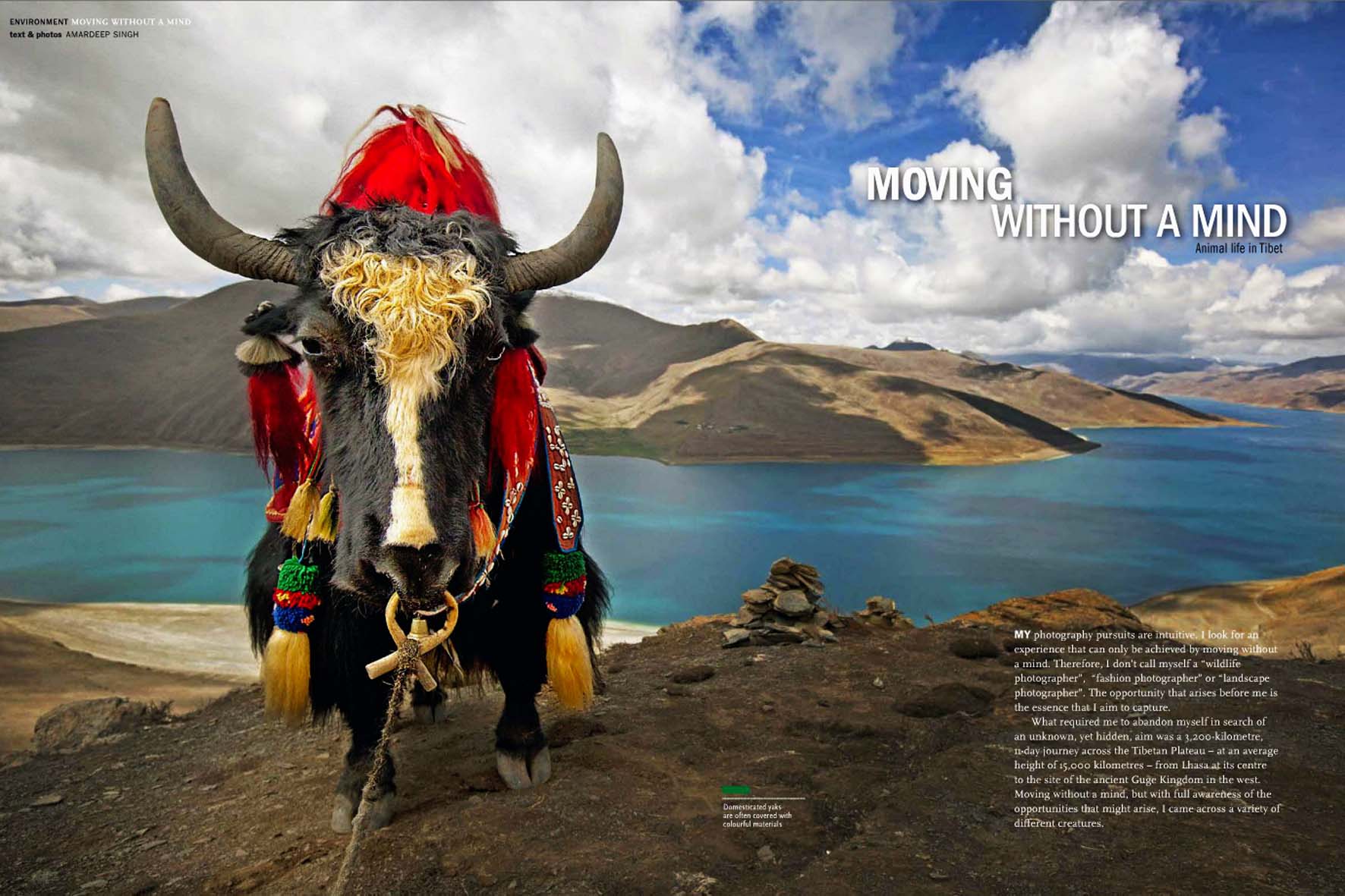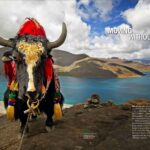
My article on Wildlife in Tibet has featured in Jan 2013 issue of Asian Geographic magazine. The relevant pages from the magazine can be viewed by clicking on the images below and scrolling. I have also provided the article content in text format for ease of reading.
MOVING WITHOUT A MIND
My photography pursuits are intuitive. I look for an experience, that can only be achieved by moving without a mind. Therefore, I don’t call myself a “wildlife photographer”, “fashion photographer”, “landscape photographer”. The opportunity that arises before me, is the essence that I aim to capture.
What required me to abandon myself in search of an unknown, yet hidden, aim was a 3,200-kilometer, 11-day journey across the Tibetan Plateau – at an average height of 15,000 feet – from Lhasa at it’s centre to the ancient Guge Kingdom in the west. Moving without a mind, but with full awareness of the opportunities that might arise, I came across a variety of different creatures.
The ‘roof of the world’ is home to a great diversity of wildlife, some of which are native to Tibet. The list of species found on the Tibetan Plateau is a long one: marmots, hares, wild dogs, wild pigs, goats, deer, musk deer, antelope, wild yaks, wild asses, horses, lynxes, rock snakes, ibexes, otters and porcupines. The ardent bird watcher will findthe crow, raven, magpie, parrot, owl, eagle, vulture, wild red duck, wild cock, partridge, white grouse, woodpecker, swallow, blackbird, lark, sandpiper, cuckoo, stork, pigeon, dove and waterfowl.
I consider myself fortunate, in the short period I visited the Tibetan Plateau, to have had the chance to come face to face with the black-necked crane, wild ass, yak, wolf, deer, sheep, pony, ibex and marmot.
The YAK(domesticated : Bos grunniens, wild : Bos mutus) s a bovine that is scattered across the upper land of the Himalayas and the Tibetan plateau. While the word “yak” is generally used to refer to both sexes, a female is called a dri, and a wild yak, a drong. Over the years, drongs have been hunted extensively, and their numbers are now limited. Domesticated yaks are used for milk, meat, transportation, while their droppings are used as fuel. Domesticated yaks do not eat grain and will starve till they are bought to a grassland. Yaks are central to Tibetan nomads : when a yak dies, in recognition of the animal’s cycle of reincarnation, its skull is placed in a monastery.
MARMOTS, rodents (M. himalayana) that belong to the genus Marmota, resemble large ground squirrels. In Tibet they are known as chiwa or piya. These highly sociable creatures live in burrows and communicate through whistles and bird-like chirps, especially when agitated. They hibernate in winter and their diet comprises of grass, roots and berries. Tibetans consider marmots holy animals, as they often sit in a praying pose. However, Tibet’s marmots are still hunted for their meat and fur.
Tibet’s WILD ASSES (Equus kiang) are called Kiang locally. This large wild ass, which is found on the Tibetan Plateau, has a dark brown coat with patches of chestnut colouring on the top and back, and a white underside. This provides excellent camouflage against the plateau’s rocky terrain. Kiangs live in herds, with dominated males maintaining the hierarchical order. They are herbivores, primarily feeding on grass, and while they sometimes drink from waterholes, their main intake of water is from the plants they eat and from snow. They are elusive by nature, always maintaining a considerable distance from humans. During the 1960s, when Chinese soldiers advanced deep into Tibet, many wild asses were shot for sport and food, severely impacting their numbers.
The Tibetan WOLF (Canis lupus chanco) is known as shanko in Tibet. Larger than the the Indian Wolf, they are very aggressive and hunt alone or in pairs, feeding on hares, marmots, goats, sheep and wild asses. As a serious threat to livestock, Tibetan wolves are targeted by humans and are also hunted for their fur.
Herds of DEER (Cervus albirostris) are quite common on the Tibetan plateau. The deer has a special status amongst the people of Tibet, as it has important significance in Buddhism. Their image receives a special place of honour at the entrance to monasteries, where a male and a female deer flank the Dharmachakra, the “Wheel of Dharma”, representing the Buddha’s teachings. Buddha is believed to have given his first sermon to his disciples, in close proximity to deer. Tibetans do not hunt deer due to their special association with Buddha.
The medium sized, grey bodied BLACK-NECKED CRANE (Grus nigricollis)earns its moniker from its black head and neck. It breeds primarily on the barley fields, meadows and riversides of the Tibetan Plateau, moving in winter to remote parts of India and Bhutan. The birds form long-lasting pair bonds and remain together during breeding and migration.
Tibetan PONIES have been bred pure for thousands of years and, as the Tibetan breeds have been confined to the Tibetan Plateau, there has been little or no mixing with Arabian, Mongolian and Turkish stock. Limited crossbreeding has resulted in a horse with a large heart and lungs and consequently lower stamina than other breeds. Tibetan ponies are used as a means of transportation and to herd livestock.
The ALPINE IBEX (Capra Ibex), which belongs to the goat family, has a distinctive pair of curved spiral horns. They generally move in herds and prefer to stay on rocky slopes and cliffs, surviving at much higher altitudes than the smaller wild goats (Capra aegagrus). The only descend to lower altitudes to feed during the winter. In Tibet, they are found in the remote western regions.
The Tibetan SHEEP is found in the highland regions, at altitudes between 2,000 and 5,000 metres. The sheep’s wool, locally known as changpel, is the raw material used in traditional Tibetan rugs.




